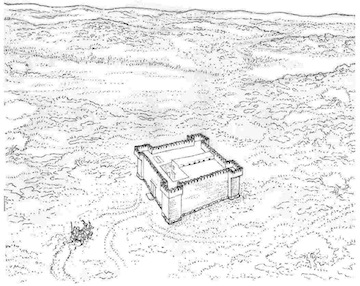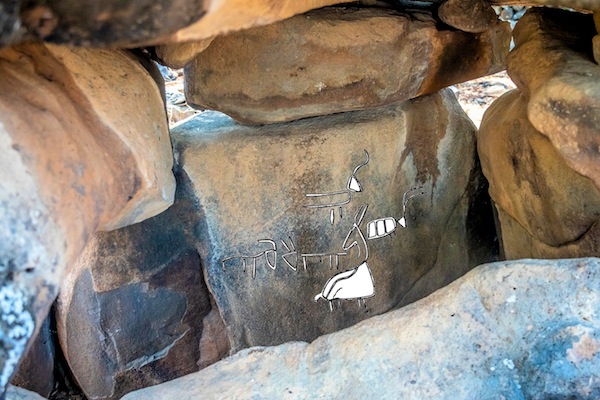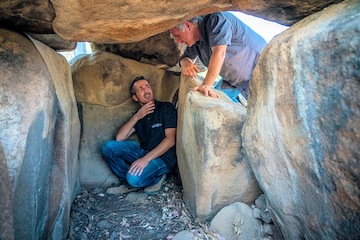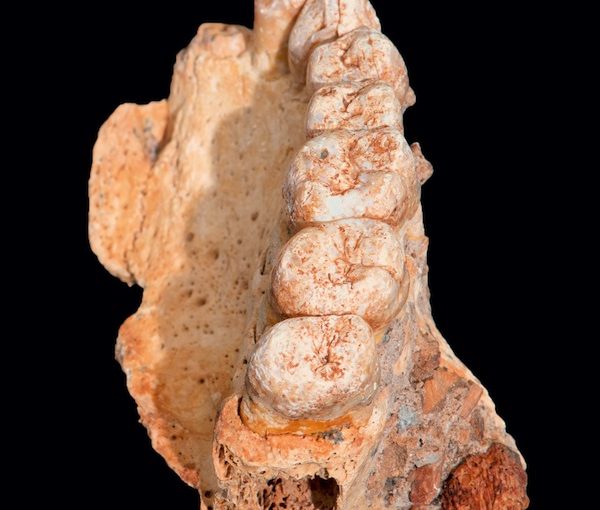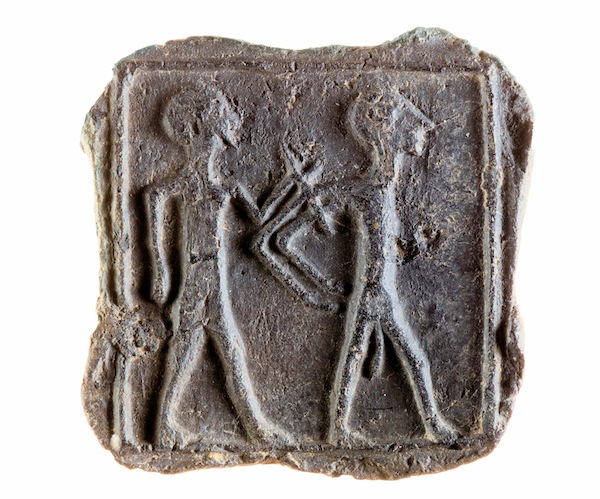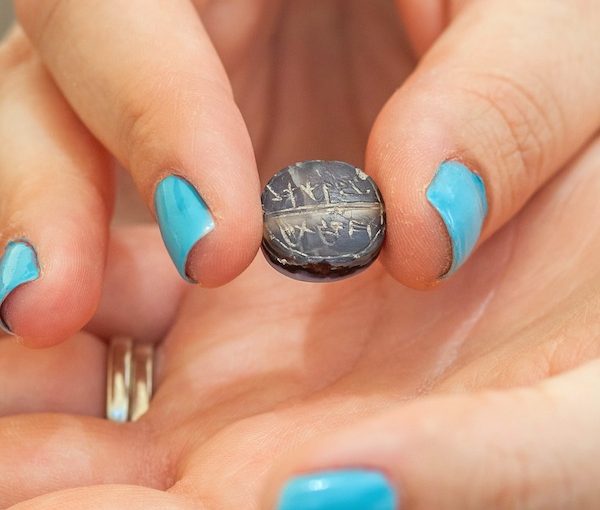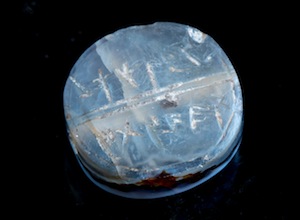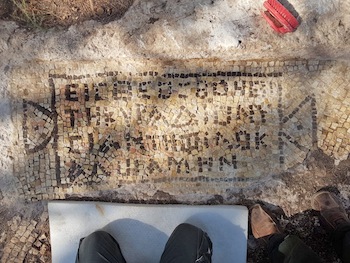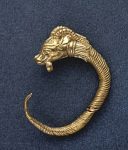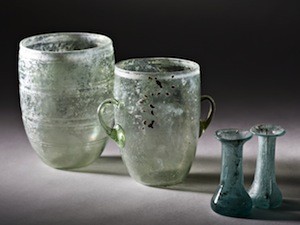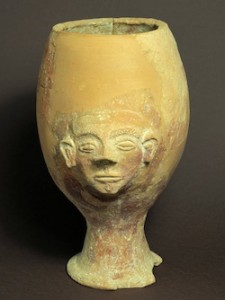Mosaics attesting to the wealth and prosperity of the ancient Samaritan community were found in Kafr Qasim, located in central Israel. (photo by Emil Aladjem, IAA)
The Israel Antiquities Authority (IAA) has sent out several press releases in the last couple of months. Here is a roundup of what has been discovered recently in a few excavations.
An agricultural estate, about 1,600 years old, was uncovered in Kafr Qasim, located in central Israel. The excavation, undertaken on behalf of the IAA and financed by the Israel Ministry of Construction and Housing prior to establishing a new northern neighbourhood, is within the boundaries of the archeological site Kh. Kafr Hatta.
The Samaritan settlement existed for about 400 years, from the end of the Roman period to the end of the Byzantine period (4th to 7th centuries CE). The site of Kh. Kafr Hatta is described in historical sources as the birthplace of Menander, the Samaritan magician, successor of Simon Magus, who was considered the father of the Gnostic sects and one of Christianity’s first converts.
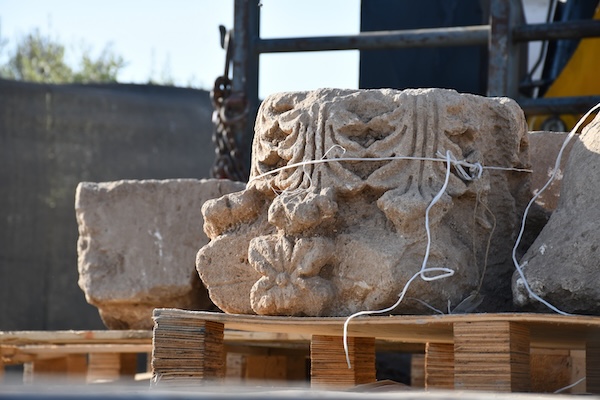
According to IAA excavation directors Alla Nagorsky and Dr. Daniel Leahy Griswold: “The size and splendour of the buildings discovered, the quality of their mosaic floors and the impressive agricultural installations, all point to the great wealth and prosperity of the local Samaritan community over the years.”
In one of the buildings, a mosaic floor was preserved, decorated with a geometric pattern and vegetal images. Alongside its central medallion are acanthus leaves combined with rare decorations of fruits and vegetables, such as grapes, dates, watermelons, artichokes and asparagus. In the entrance to this room was a partially preserved Greek inscription wishing the building’s owner Good Luck!; the owner’s first name was common in Samaritan communities.
In the northern part of the estate were found an olive press, a warehouse building and a public purification bath, a mikvah. The proximity of the oil press to the mikvah was probably used to produce olive oil in purity. The olive press was carefully planned, consisting of two wings; the northern wing contained the main production areas, while auxiliary rooms were erected in the southern wing. In the production areas, two screw presses were found, as well as a large basin in which the olives were crushed.

Over the years, the estate saw dramatic changes.
“The wealth and luxury of the buildings were replaced by oil production and agricultural installations. New walls damaged the mosaic floors, and the magnificent capitals and columns were integrated within the new walls,” said Nagorsky. She suggested that these changes are related to the Samaritan Revolts under the Byzantine rule – a series of 5th to 6th century CE uprisings against the Byzantine emperors, who enforced restrictive laws on members of other religions.
“What makes this site particularly interesting is that, unlike some of the other Samaritan sites that were destroyed in these revolts, the agricultural estate in Kafr Qasim actually continued in use, and even preserved its Samaritan identity – as evidenced by the Samaritan ceramic oil lamps uncovered in our excavation,” Nagorsky said.
According to Israeli Minister of Heritage, Rabbi Amichai Eliyahu, “The discovery of the Samaritan agricultural estate illuminates another chapter in the common shared story of the ancient peoples of this land; foremost, in this period, the Jews and the Samaritans. These two ancient communities led their lives based on the Torah and shared common roots, and also experienced similar hardships during periods of antagonistic rule…. These physical remains are another reminder that our heritage in this land is deep and multifaceted.”
* * *

A monumental dam excavated in the Siloam Pool in the City of David National Park has now been dated in a joint study by the IAA and the Weizmann Institute of Science, to the reign of the kings of Judah, Joash or Amaziah. Its construction may have been a creative solution to a climate crisis about 2,800 years ago, according to the researchers. The research was published in the scientific journal PNAS.
The wall uncovered in excavations of the Siloam Pool in the City of David National Park was built around 805-795 BCE. Its discovery was made by excavation directors Dr. Nahshon Szanton, Itamar Berko and Dr. Filip Vukosavovic on behalf of the IAA.
“This is the largest dam ever discovered in Israel and the earliest one ever found in Jerusalem,” the directors stated in a press release. “Its dimensions are remarkable: about 12 metres high, over 8 metres wide, and the uncovered length reaches 21 metres – continuing beyond the limits of the current excavation. The dam was designed to collect waters from the Gihon Spring, as well as floodwaters flowing down the main valley of ancient Jerusalem (the historical Tyropoeon Valley) to the Kidron Stream, providing a dual solution for both water shortages and flash floods.”
Dr. Johanna Regev and Prof. Elisabetta Boaretto of the Weizmann Institute explained: “Short-lived twigs and branches embedded in the dam’s construction mortar provided a clear date at the end of the 9th century BCE, with extraordinary resolution of only about 10 years – a rare achievement when dating ancient finds. To complete the climatic reconstruction, we integrated this dating with existing climate data from Dead Sea cores, from Soreq Cave and from solar activity records influencing the formation of certain chemical elements. All the data pointed to a period of low rainfall in the Land of Israel, interspersed with short and intense storms that could cause flooding. It follows that the establishment of such large-scale water systems was a direct response to climate change and arid conditions that included flash floods.”
The newly uncovered structure joins two other water systems from the same period discovered in the City of David: a tower that dammed the Gihon Spring and a water system that gathered water from the Gihon, directed through a channel into the Siloam Pool, where it was joined by floodwaters blocked by the dam.
These systems reflect comprehensive urban planning for managing Jerusalem’s water supply as early as the late 9th century BCE – clear evidence of the city’s power and sophistication.
* * *
Lamp wicks made of textiles, approximately 4,000 years old – among the oldest known in the entire world – were discovered during an archeological dig at the Newe Efraim antiquities site near Yehud, Israel. The wicks, uncovered in an IAA excavation, funded as part of development works by the Israel Lands Authority to establish a new neighbourhood in the city of Yehud, were preserved inside clay lamps, used for illumination in the Intermediate Bronze Age (circa 2500-2000 BCE).
The study was published in the scientific journal ’Atiqot, Vol. 118, published by the IAA.
According to IAA researchers Dr. Naama Sukenik and Dr. Yonah Maor: “This is a unique discovery that we did not expect could ever be found in the moist Mediterranean climate…. Although wicks were a common product for lighting in the ancient world, the fact that they are made of organic fibres makes it difficult to discover them in an archeological dig. Even in cases where the organic matter is preserved, such as in desert climate conditions, it is difficult to identify a wick, unless found inside a lamp, since it has no special characteristics to distinguish it from any group of fibres, threads or ropes…. The fact that three wicks were found – and that one of them survived in its entirety, is especially surprising in the humid climate of the coastal plain.”
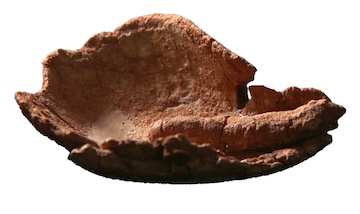
According to Dr. Gilad Itach, Yossi Elisha and Yaniv Agmon, the excavation directors on behalf of the IAA, “The wicks were discovered inside oil lamps uncovered in the graves alongside other burial offerings, including various types of pottery, animal bones, metal weapons and jewelry. While these lamps must have been used to illuminate the underground dark burial space during the burial ceremony itself, it seems that this was not their only function. The fire burning in a lamp has been associated with magical power since the dawn of humankind…. Admittedly, the Intermediate Bronze Age population in the Land of Israel did not leave any writings behind, but various sources from around the ancient Near East demonstrate the central role of fire in burial ceremonies. Just like today, thousands of years ago, the fire burning in a lamp symbolized the human soul. The common term we use today, ‘ner neshama,’ ‘the flame of the soul,’ probably originated thousands of years ago.”
Traces of soot were found in the wicks tested in the study, indicating these lamps were used; seemingly lit while the grave was prepared and/or during the burial ceremony. The analysis also revealed that the wicks were apparently made from reused linen fabric. “It is unlikely that an expensive textile such as linen would have been woven especially for an object intended for combustion,” said Sukenik. “We speculate that the wicks were recycled from other textiles, after their original purpose was completed…. The secondary use of textiles indicates smart economic conduct, in which precious raw materials were maximally utilized.”
– Courtesy Israel Antiquities Authority



